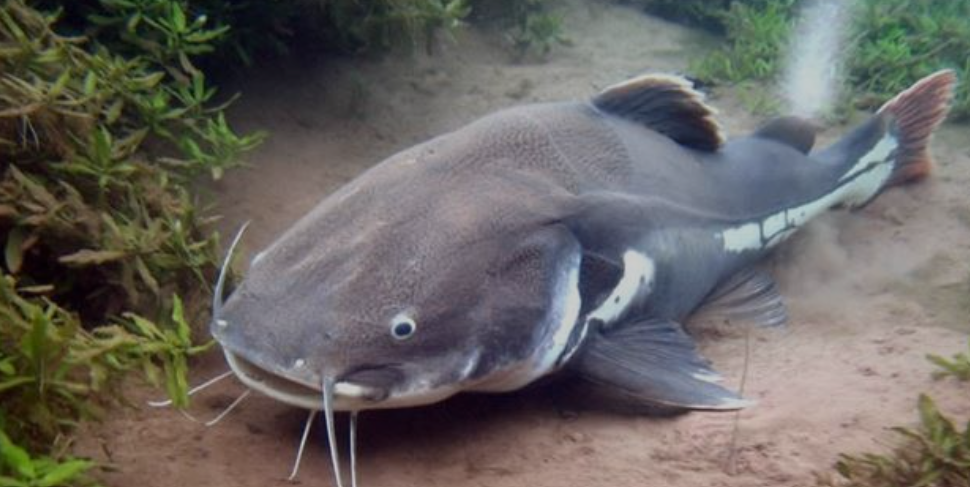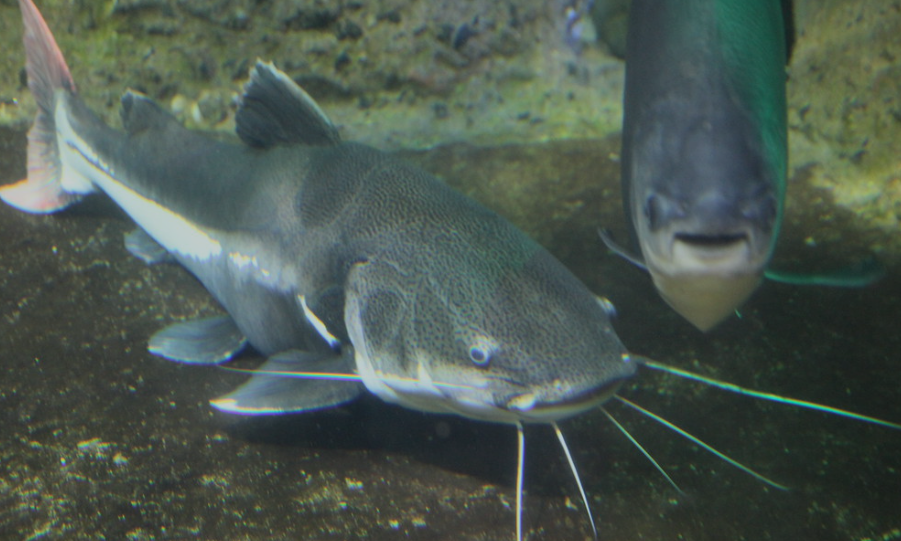
Catfish are a diverse group of freshwater and some brackish water fish belonging to the order Siluriformes. They are easily recognized by their whisker-like barbels around the mouth, which help them sense food in murky waters. Catfish range in size from tiny aquarium species, like Corydoras, to enormous species such as the Wels Catfish, which can grow over 9 feet long. They are found on every continent except Antarctica, inhabiting rivers, lakes, ponds, and some estuaries.
Many species can survive in low-oxygen environments, and some, like the African Clarias, can breathe air and move short distances over land. This adaptability has made catfish an important species for aquaculture, especially in regions such as Southeast Asia, Africa, and North America. Catfish are omnivorous; their diets include insects, small fish, algae, detritus, and sometimes even small amphibians, depending on the species. This versatility in feeding behavior allows them to occupy a wide range of ecological niches.
Some catfish species, like the Upside-Down Catfish, have evolved unusual behaviors such as swimming inverted to feed at the water surface. Others, like the Banjo Catfish, are nocturnal and spend much of their time buried in sand or mud, emerging at night to hunt for food. Many catfish are territorial and have developed defensive adaptations, including spines on their dorsal and pectoral fins that can deliver painful wounds to predators or threats.
Reproduction in catfish is equally varied. Some species, like the Hoplosternum, build bubble nests and care for their young, while others scatter eggs in protected areas. Parental care can range from guarding the eggs to carrying them in the mouth for a period. This reproductive diversity is part of the reason catfish have successfully colonized a wide range of habitats. Moreover, certain species have become invasive in non-native regions, demonstrating their ability to compete successfully with local fish populations.
They are a staple food source in many countries, valued for their firm, mild-flavored flesh, and are widely farmed in aquaculture. Additionally, catfish are popular in sport fishing due to their size and fighting ability, especially species like the Channel, Blue, and Flathead Catfish in North America.

Catfish Species
Channel Catfish (Ictalurus punctatus)
The Channel Catfish is one of the most common freshwater catfish in North America. Recognizable by its forked tail and small spots on its body, it inhabits rivers, lakes, and reservoirs. These fish are omnivorous, feeding on insects, smaller fish, and plant matter. Channel Catfish are popular among anglers due to their fighting ability and are often farmed for food.
Blue Catfish (Ictalurus furcatus)
Blue Catfish are among the largest North American catfish species, capable of reaching over 100 pounds. They have a bluish-gray coloration and a forked tail, similar to channel catfish. Preferring large rivers and reservoirs, they are apex predators, consuming fish, crustaceans, and occasionally waterfowl. Blue Catfish are prized for their size and taste.
Flathead Catfish (Pylodictis olivaris)
Flathead Catfish are easily recognized by their broad, flattened heads and yellow to brown mottled bodies. Native to the central and eastern United States, they thrive in rivers with deep pools. These are aggressive predators, mainly feeding on live fish. Anglers seek them for their challenging catch and excellent flavor.
Wels Catfish (Silurus glanis)
The Wels Catfish is native to Europe and parts of Asia and is among the largest freshwater fish in the world. They can grow over 9 feet in length and weigh several hundred pounds. Wels Catfish inhabit lakes, rivers, and reservoirs and feed on fish, frogs, and even small mammals. They are a top predator in their ecosystems.
Redtail Catfish (Phractocephalus hemioliopterus)
The Redtail Catfish is a striking South American species, easily identified by its reddish-orange tail and large size. Found in the Amazon, Orinoco, and Essequibo river basins, it prefers slow-moving rivers. Redtail Catfish are omnivorous, feeding on fish, crustaceans, and plant matter. They are popular in large aquariums due to their vibrant appearance.
Pictus Catfish (Pimelodus pictus)
Pictus Catfish are small, attractive South American catfish with spotted bodies and long whiskers. They are popular in the aquarium trade for their peaceful nature and bottom-feeding habits. Native to rivers in Peru and Brazil, these catfish scavenge for leftover food and small invertebrates.
Striped Raphael Catfish (Platydoras armatulus)
Striped Raphael Catfish are nocturnal, armored catfish native to South America. They have a brown body with horizontal black stripes and a tough exterior. These fish hide during the day and emerge at night to feed on invertebrates and plant material. They are commonly kept in aquariums due to their hardiness.
Clarias Catfish (Clarias gariepinus)
Also known as the African Sharptooth Catfish, this species is widespread in Africa and parts of Asia. Clarias Catfish have an elongated body and can breathe atmospheric air, allowing survival in low-oxygen waters. They are opportunistic feeders and are commonly farmed for food due to their fast growth and adaptability.
Corydoras Catfish (Corydoras spp.)
Corydoras Catfish are small, peaceful freshwater fish native to South America. They have armored plates along their bodies and are known for their social behavior, often swimming in groups. Corydoras feed on detritus and small invertebrates, making them popular in community aquariums.
Walking Catfish (Clarias batrachus)
Walking Catfish are native to Southeast Asia and are named for their ability to move across land using their pectoral fins. They thrive in flooded fields, ponds, and slow-moving rivers. This species is hardy and can survive out of water for hours, feeding on fish, insects, and plant matter.
Upside-Down Catfish (Synodontis nigriventris)
The Upside-Down Catfish is a unique African species that swims inverted most of the time. This behavior allows it to feed on insects and algae from the water surface. It has a dark dorsal side and a lighter ventral side, aiding camouflage. Upside-Down Catfish are popular in aquariums due to their unusual behavior.
Ghost Catfish (Kryptopterus vitreolus)
Ghost Catfish, also known as Glass Catfish, are small, transparent freshwater fish from Southeast Asia. Their bodies are nearly see-through, allowing observation of internal organs. They are peaceful, schooling fish that feed on small invertebrates. Their unique appearance makes them a favorite in community aquariums.
Black Bullhead (Ameiurus melas)
The Black Bullhead is a small to medium-sized North American catfish, easily identified by its dark body and slightly forked tail. They are highly adaptable, inhabiting muddy ponds, rivers, and lakes. Black Bullheads are opportunistic feeders, consuming insects, small fish, and detritus. Their resilience makes them common in both wild and stocked waters.
Brown Bullhead (Ameiurus nebulosus)
Brown Bullhead catfish are widespread in North America and are characterized by a mottled brown coloration and a slightly flattened head. These fish thrive in slow-moving or still waters with muddy bottoms. They feed on insects, crustaceans, and small fish, and are valued by anglers for their hardiness and strong fight.
White Catfish (Ameiurus catus)
The White Catfish is native to the Atlantic and Gulf Coast regions of the United States. Recognized by its pale bluish-white to gray body, it prefers rivers, reservoirs, and brackish waters. White Catfish are opportunistic feeders, consuming insect larvae, small fish, and plant material. They are often introduced into water bodies to control unwanted species.
Upside-Down Channel Catfish (Ictalurus punctatus variant)
This unique variant of the channel catfish exhibits occasional inverted swimming behavior, similar to the African Upside-Down Catfish. Found in specific regions of North America, they use this behavior to graze on insects and algae near the surface. They maintain the same omnivorous diet as regular channel catfish.
Striped Raphael Catfish (Platydoras costatus)
A close relative of the standard Striped Raphael, this species features more pronounced horizontal stripes along its armored body. Native to the Amazon and Orinoco basins, it is nocturnal and prefers hiding under rocks or driftwood during the day. Their diet consists of invertebrates, detritus, and plant matter.
Pictus Catfish Longfin Variant (Pimelodus pictus longfin)
This is a long-finned variant of the Pictus Catfish, prized in aquariums for its extended, flowing fins and striking spots. Like its standard form, it is a bottom-dweller feeding on leftover food, insects, and small invertebrates. They are highly social and prefer to be in groups.
Giant Cory Catfish (Corydoras aeneus giganteus)
This rare variant of the Bronze Corydoras grows larger than typical Corydoras species, reaching up to 4–5 inches. Native to South American rivers, they are peaceful, social fish that thrive in groups. They feed primarily on small invertebrates and detritus, making them excellent cleaners in aquariums.
Iridescent Shark (Pangasianodon hypophthalmus)
Despite its name, the Iridescent Shark is a type of catfish native to Southeast Asia. It is known for its silvery, shimmering body and shark-like shape. Growing rapidly to large sizes in rivers and aquaculture ponds, it feeds on both plant matter and small aquatic animals. Popular in large aquariums, it requires plenty of space due to its size.
Tiger Shovelnose Catfish (Pseudoplatystoma fasciatum)
The Tiger Shovelnose Catfish is a striking South American species, recognized for its elongated body, broad flattened head, and bold vertical stripes. Found in the Amazon and Orinoco rivers, it is a predatory species feeding on fish and crustaceans. Highly sought after by hobbyists, it requires a large tank and careful management due to its size and hunting instincts.
Redhook Silver Catfish (Kryptopterus geminus)
The Redhook Silver Catfish is a small, schooling freshwater species from Southeast Asia. Known for its translucent body and reddish pectoral fins, it is peaceful and thrives in community aquariums. These catfish feed primarily on small invertebrates and plant matter, often swimming near the mid- to upper-water levels rather than strictly at the bottom.
Glass Catfish (Kryptopterus bicirrhis)
Closely related to the Ghost Catfish, the Glass Catfish has a completely transparent body, allowing a clear view of its internal organs. Native to rivers in Thailand and Malaysia, it is a gentle, schooling fish that feeds on tiny invertebrates. Its unique see-through appearance makes it a favorite for aquarists seeking unusual species.
Asian Stone Catfish (Hara jerdoni)
The Asian Stone Catfish is a small, bottom-dwelling species native to streams in India and Southeast Asia. It has a flattened body and cryptic brown coloration that blends into gravel and sand substrates. These catfish feed on small invertebrates and organic detritus and are appreciated for their peaceful nature and ability to hide in aquariums.
Banjo Catfish (Bunocephalus coracoideus)
Banjo Catfish are named for their flat, elongated bodies that resemble the shape of a banjo. Native to South American rivers, they are nocturnal and bury themselves in sand or mud during the day. They feed on small invertebrates and detritus, and their unique shape and behavior make them popular among aquarium enthusiasts.
Striped Raphael Catfish Longfin Variant (Platydoras armatulus longfin)
This long-finned variant of the Striped Raphael Catfish has more pronounced fins, giving it a graceful swimming appearance. Native to the Amazon Basin, it is nocturnal, feeding on insects, worms, and plant matter. Its armored body makes it hardy and a good choice for community aquariums.
Hoplosternum Catfish (Hoplosternum littorale)
Hoplosternum, also known as the Brown Hoplo, is a South American armored catfish. It is known for its ability to breathe air, which allows it to survive in oxygen-poor waters. Hoplosternum feeds on detritus, plant matter, and small invertebrates. It is popular in aquariums due to its interesting behaviors and bubble-nesting habits.
Leopard Catfish (Amblydoras nauticus)
The Leopard Catfish is a small, spotted catfish from South American rivers. Its body is covered with irregular black spots, giving it a distinctive leopard-like appearance. It is nocturnal, peaceful, and feeds on worms, small crustaceans, and detritus. Its unique patterning makes it a favorite among hobbyists.